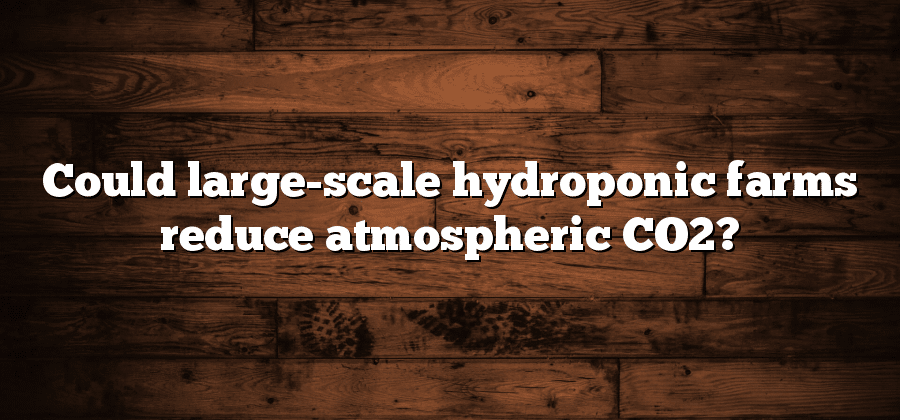Sustainable Agriculture and Climate Change Mitigation
One of the pressing challenges facing the global agricultural sector today is climate change. The agricultural industry is not only affected by climate change but also contributes to its acceleration through greenhouse gas emissions and deforestation. However, sustainable agricultural practices have the potential to mitigate climate change while ensuring food security and income generation for farmers.
Implementing sustainable agriculture techniques can help reduce greenhouse gas emissions from the sector. For instance, adopting precision farming techniques such as precision irrigation and fertilization can lower the use of synthetic fertilizers, resulting in a decrease in nitrous oxide emissions. In addition, the use of cover crops and agroforestry systems can sequester carbon, thus mitigating the impacts of climate change. Furthermore, sustainable practices like organic farming and integrated pest management reduce the reliance on chemical inputs, thereby reducing the carbon footprint of agriculture.
Efficient Nutrient Management in Hydroponic Systems
Efficient nutrient management plays a crucial role in hydroponic systems, ensuring optimal plant growth and minimizing environmental impacts. Hydroponics, which involves the cultivation of plants in nutrient-rich water solutions instead of traditional soil-based systems, allows for precise control over nutrient availability. By carefully monitoring and adjusting nutrient levels, growers can ensure that plants receive the necessary elements for healthy development, while minimizing waste and pollution.
In hydroponic systems, nutrients are provided directly to the root zone, allowing plants to absorb them more efficiently compared to traditional soil cultivation. This targeted approach to nutrient delivery can lead to higher yields and healthier plants. Additionally, the controlled environment of hydroponics reduces the risk of nutrient leaching, a common issue in conventional farming where excess nutrients can be washed away by rain or irrigation, polluting water bodies. Overall, efficient nutrient management in hydroponic systems not only benefits crop production but also contributes to sustainable agriculture practices by minimizing nutrient runoff and protecting water quality.
Minimizing Soil Erosion and Land Degradation
Soil erosion and land degradation pose significant threats to agricultural productivity and environmental sustainability. However, by implementing certain strategies and practices, we can minimize these issues and protect our valuable natural resources.
One effective approach is the adoption of conservation tillage techniques. This method involves reducing or eliminating intensive tillage, which can cause soil erosion by exposing bare soil to wind and water erosion. By leaving crop residues on the field or implementing cover crops, we can protect the soil from erosion, enhance water infiltration, and improve soil structure. Conservation tillage also helps to sequester carbon in the soil, contributing to climate change mitigation.
An additional strategy for minimizing soil erosion and land degradation is the implementation of agroforestry practices. Agroforestry involves integrating trees, crops, and animals on the same piece of land. Trees provide multiple benefits, including preventing wind erosion, stabilizing soil with their root systems, and enhancing the overall biodiversity of the ecosystem. Agroforestry systems can also improve water quality, reduce nutrient runoff, and provide additional income streams for farmers through the sale of timber, fruits, or nuts. By adopting agroforestry practices, farmers can not only minimize soil erosion and land degradation but also improve the overall sustainability and resilience of their agricultural systems.
Reduced Water Usage in Hydroponics
With the increasing concern over water scarcity and the need for sustainable agricultural practices, hydroponics has emerged as a promising solution to reduce water usage in farming. Hydroponics is a cultivation method that utilizes nutrient-rich water rather than soil to grow plants. By utilizing a closed and recirculating system, hydroponics significantly reduces water consumption compared to traditional soil-based farming methods.
In hydroponics, water is efficiently used as it gets recycled within the system. Nutrient-rich water is delivered directly to the plant roots, ensuring optimal uptake and minimizing water wastage. Additionally, hydroponic systems can be equipped with sensors and automated controls to monitor and adjust water levels, preventing overwatering and reducing water loss through evaporation. This precision-based approach maximizes water efficiency and allows for precise control over the plant’s water requirements. As a result, hydroponics offers a sustainable solution for agriculture by minimizing water usage and promoting efficient resource allocation.
Controlled Environment Agriculture for CO2 Reduction
Controlled Environment Agriculture (CEA) holds great promise in mitigating the effects of rising CO2 levels on our environment. By utilizing advanced technologies and carefully controlling growing conditions, CEA systems can significantly reduce CO2 emissions compared to traditional open field farming. In CEA systems, crops are cultivated in enclosed structures such as greenhouses or vertical farms, where temperature, humidity, and CO2 levels can be precisely regulated.
One key advantage of CEA is its ability to optimize photosynthesis, the process by which plants convert CO2 into oxygen. By maintaining ideal conditions for plant growth, CEA ensures that crops efficiently absorb and utilize atmospheric CO2. Moreover, CEA systems often incorporate innovative technologies such as carbon dioxide scrubbers, which remove excess CO2 from the air and prevent its release into the atmosphere. As a result, CEA not only reduces CO2 emissions but also enhances the overall efficiency of carbon capture and utilization within agricultural systems.
Implementing CEA on a larger scale has the potential to make a significant impact on global CO2 reduction efforts. However, it is important to acknowledge that transitioning to a controlled environment agriculture system requires substantial investments in infrastructure, technology, and workforce training. Nevertheless, the long-term benefits of CEA, including improved resource efficiency and reduced environmental footprint, make it a compelling solution for CO2 reduction in the agricultural sector. As ongoing advancements continue to make CEA more accessible and affordable, its widespread adoption could be a crucial step towards achieving a more sustainable and climate-resilient future.






